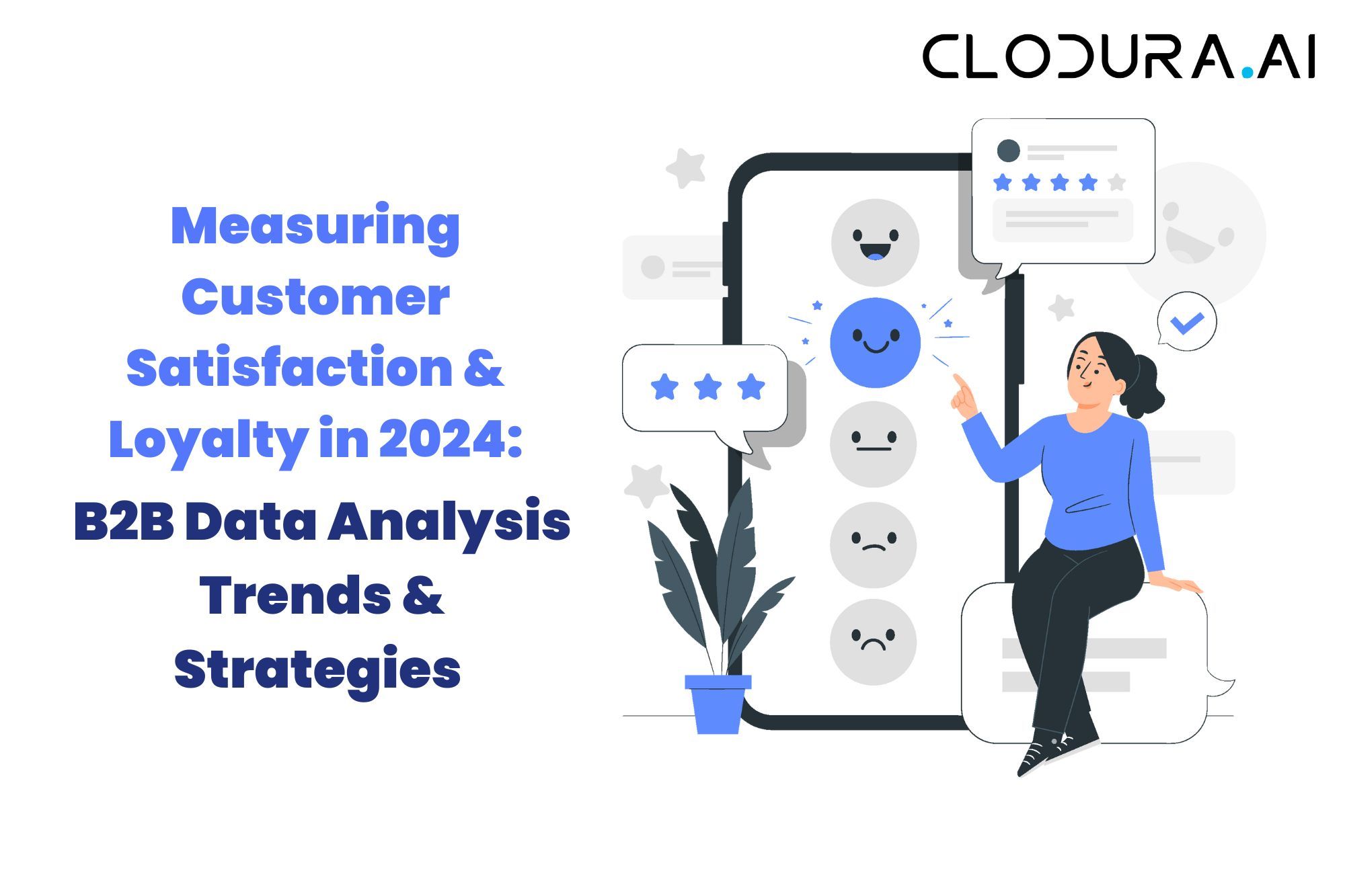In 2024, understanding customer satisfaction and loyalty is crucial for B2B businesses seeking sustainable growth. As we delve into the trends and strategies shaping data analysis, it becomes evident that traditional methods are evolving to meet the dynamic needs of the modern market. Customer satisfaction is no longer measured by mere transactional experiences, but rather by the holistic journey encompassing product quality, service excellence, and seamless interactions.
In this blog, we unravel the innovative approaches and emerging technologies that are revolutionizing how businesses gauge customer sentiment and loyalty. From advanced analytics to predictive modeling, the landscape of data analysis is rapidly shifting, empowering businesses to proactively meet customer expectations and drive brand advocacy.
Join us as we navigate through the transformative B2B data analysis trends, uncovering actionable insights that can amplify customer satisfaction, nurture loyalty, and ultimately, drive business success in 2024.
Understanding the Value of Customer Satisfaction
Customer satisfaction is more than just a buzzword. It is a vital metric that directly impacts a company's success. Satisfied customers are more likely to repurchase, recommend a brand to others, and remain loyal in the long run. By understanding the value of customer satisfaction, businesses can prioritize customer-centric strategies and improve their overall customer experience.
Building Customer Relationships
Customer satisfaction is the foundation for building strong, lasting relationships with clients. It fosters trust and loyalty, creating a positive customer experience. When customers are satisfied with a company's products or services, they are more likely to become repeat customers. These loyal customers not only continue to support the business but also become advocates, spreading positive word-of-mouth and attracting new customers.
Furthermore, satisfied customers are more likely to engage in long-term partnerships with the company. They see the value in maintaining a relationship with a trusted provider and are less likely to switch to a competitor. This stability in customer relationships provides businesses with a steady revenue stream and reduces the costs associated with acquiring new customers.
Influencing Brand Perception
Customer satisfaction plays a significant role in shaping a company's brand perception. Positive experiences lead to positive word-of-mouth, which can boost brand reputation and increase credibility. When customers are satisfied, they are more likely to share their positive experiences with friends, family, and colleagues. This organic promotion helps to build brand awareness and attract potential customers.
On the other hand, negative experiences can tarnish a brand's image and reputation. Dissatisfied customers are more likely to share their negative experiences, both in person and online. With the rise of social media and online review platforms, these negative reviews can quickly spread and influence potential customers' perception of the brand. Therefore, it is crucial for businesses to prioritize customer satisfaction and address any issues promptly to prevent potential damage to their brand reputation.
Moreover, satisfied customers not only contribute to positive brand perception but also become brand advocates. They willingly share their positive experiences on social media platforms, write glowing reviews, and recommend the brand to others. These testimonials and recommendations serve as powerful endorsements, further enhancing the brand's credibility and attracting new customers.

Driving Continuous Improvement
Customer satisfaction serves as a valuable feedback mechanism for businesses to identify areas for improvement. By actively seeking customer feedback and measuring satisfaction levels, companies can gain insights into their strengths and weaknesses. This information can then be used to drive continuous improvement initiatives, ensuring that the company consistently meets or exceeds customer expectations.
Through customer satisfaction surveys, businesses can gather specific feedback on various aspects of their products, services, and overall customer experience. This data can help identify pain points, areas of improvement, and potential opportunities for innovation. By addressing these areas, businesses can enhance their offerings, streamline processes, and stay ahead of the competition.
Furthermore, customer satisfaction data can also be used to benchmark performance against industry standards and competitors. By comparing satisfaction levels with industry averages, businesses can identify areas where they excel and areas where they need to catch up. This competitive analysis allows companies to set realistic goals and develop strategies to outperform their competitors.
Finally, customer satisfaction is not just a metric to be measured; it is a fundamental aspect of business success. By prioritizing customer satisfaction, businesses can build strong customer relationships, influence brand perception, and drive continuous improvement. Understanding the value of customer satisfaction empowers companies to deliver exceptional customer experiences and stay ahead in today's competitive market.
Identifying Tactics to Measure Customer Satisfaction
Measuring customer satisfaction requires a thoughtful approach that goes beyond simply asking customers if they are satisfied. It involves gathering relevant data, analyzing it effectively, and drawing actionable insights. The following tactics can help businesses accurately measure customer satisfaction:
Customer Surveys
Sending well-designed customer surveys is an effective way to collect feedback and gauge satisfaction levels. These surveys should be thoughtfully crafted, ensuring they are concise, relevant, and easy to complete. By asking the right questions, businesses can gain valuable insights into customer perceptions and areas for improvement.
For example, a company in the hospitality industry might ask customers to rate their overall experience, the cleanliness of the facilities, the friendliness of the staff, and the quality of the amenities. By collecting this data, the company can identify specific areas where they excel and areas where they need to make improvements.
Customer surveys can also be used to gather demographic information, allowing businesses to segment their customers and tailor their products or services to specific target markets. This level of personalization can greatly enhance customer satisfaction and loyalty.

Net Promoter Score (NPS)
The Net Promoter Score is a widely used metric that measures customer loyalty and satisfaction. It asks customers to rate the likelihood of recommending a company or product on a scale of 0 to 10. Based on the responses, customers are classified as promoters, passives, or detractors. The NPS provides a straightforward indicator of overall customer satisfaction and loyalty.
For instance, a software company might ask its customers, "On a scale of 0 to 10, how likely are you to recommend our software to a friend or colleague?" Customers who respond with a score of 9 or 10 are considered promoters, indicating high satisfaction and a strong likelihood of recommending the software. On the other hand, customers who respond with a score of 6 or below are classified as detractors, indicating low satisfaction and a higher likelihood of negative word-of-mouth.
By calculating the NPS, businesses can track changes in customer satisfaction over time and compare their scores to industry benchmarks. This metric provides a clear and quantifiable measure of customer loyalty, allowing businesses to identify areas for improvement and prioritize their efforts accordingly.
Customer Behavior Analysis
Monitoring customer behavior can provide valuable insights into satisfaction levels. By analyzing purchase patterns, return rates, and engagement metrics, businesses can gain a deeper understanding of how satisfied their customers are. This data can help identify areas for improvement and tailor strategies to enhance customer satisfaction.
For example, an e-commerce company might analyze customer behavior on their website, looking at metrics such as click-through rates, time spent on each page, and the number of abandoned shopping carts. By examining these data points, the company can identify potential pain points in the customer journey and take steps to address them.
Additionally, customer behavior analysis can help businesses identify trends and patterns that may impact satisfaction levels. For instance, if a particular product consistently receives high return rates, it may indicate a quality issue that needs to be addressed. By proactively addressing these issues, businesses can improve customer satisfaction and reduce churn.
Overall, accurately measuring customer satisfaction requires a combination of tactics, including customer surveys, Net Promoter Score, and customer behavior analysis. By implementing these strategies, businesses can gain valuable insights into customer perceptions, identify areas for improvement, and ultimately enhance overall satisfaction and loyalty.
Analyzing Customer Feedback to Track Satisfaction
Collecting customer feedback is only the first step in measuring satisfaction. To effectively track satisfaction levels, businesses must analyze this feedback and draw actionable insights. Through careful analysis, companies can identify trends, patterns, and specific pain points that require attention.
Here are some key steps to analyze customer feedback:
Text Analytics
Text analytics involves using natural language processing and machine learning techniques to analyze unstructured data, such as customer reviews and comments. By extracting key themes, sentiment, and opinions from this data, businesses can gain a comprehensive understanding of customer satisfaction levels and identify areas that need improvement.
Segmentation Analysis
Segmenting customers based on demographics, purchase history, and other relevant factors can provide valuable insights into satisfaction levels within different customer groups. By comparing satisfaction scores across segments, businesses can identify areas of strength and weakness and tailor strategies accordingly.
Comparative Analysis
Comparative analysis involves benchmarking customer satisfaction against competitors or industry standards. This analysis can help businesses understand how they stack up and identify areas where they need to improve to remain competitive. It also provides insights into industry-wide trends and best practices for customer satisfaction.

Trends in B2B Data Analysis for Measuring Satisfaction and Loyalty
The field of data analysis is continuously evolving, and B2B companies need to stay up-to-date with the latest trends to effectively measure satisfaction and loyalty. Here are some of the key trends in B2B data analysis:
Advanced Analytics
Advanced analytics techniques, such as predictive modeling and machine learning, are revolutionizing the way businesses analyze and interpret customer data. By leveraging these methods, companies can uncover hidden patterns and make data-driven decisions to enhance customer satisfaction.
Real-time Data Analysis
Real-time data analysis allows businesses to monitor customer satisfaction and loyalty in real-time, enabling immediate action to address any issues. With the help of automation and cloud-based technologies, companies can access and analyze data in real-time, providing them with valuable insights to improve customer satisfaction promptly.
Customer Journey Mapping
Customer journey mapping involves visualizing customer interactions and touchpoints throughout their journey with a company. By mapping out the entire customer journey, businesses can identify pain points, moments of delight, and areas for improvement. This method allows for a more holistic understanding of customer satisfaction and loyalty.
Strategies for Effectively Measuring Customer Satisfaction and Loyalty
Implementing effective strategies is vital for accurately measuring customer satisfaction and loyalty. Here are some strategies to consider:
Establish Clear Goals and KPIs
Before embarking on any customer satisfaction measurement initiative, businesses must clearly define their goals and key performance indicators (KPIs). This clarity ensures that efforts are aligned with business objectives and enables effective tracking and evaluation of satisfaction levels.
Implement Regular Customer Feedback Mechanisms
Regularly gathering customer feedback is crucial for timely insights and continuous improvement. Implementing various feedback mechanisms, such as customer surveys, NPS, and social listening, allows businesses to capture feedback consistently and stay connected with customers' evolving needs and preferences.
Invest in Data Visualization and Reporting
Presenting data in a visually appealing and easily digestible manner is essential for effective communication and decision-making. Investing in data visualization and reporting tools can help organizations streamline their data analysis process and convey insights to stakeholders effectively.
Key Metrics for Analyzing Customer Satisfaction and Loyalty
Measuring customer satisfaction and loyalty requires the evaluation of numerous metrics. Here are some key metrics to consider:
Customer Satisfaction Score (CSAT)
The CSAT metric measures overall customer satisfaction based on a customer survey. It typically asks customers to rate their satisfaction on a scale of 1 to 5 or 1 to 10. Analyzing CSAT scores over time allows businesses to track changes in satisfaction levels and identify areas for improvement.
Customer Effort Score (CES)
The CES metric focuses on the ease of doing business with a company. It measures the effort customers have to put into resolving an issue, making a purchase, or using a product. By minimizing customer effort, businesses can enhance satisfaction and improve loyalty.
Churn Rate
The churn rate measures the percentage of customers who stop using a company's products or services within a given period. Tracking churn rate provides insights into customer retention and loyalty. A high churn rate may indicate dissatisfaction or a gap in customer service.
Tools and Technology for B2B Data Analysis
In today's data-driven world, various tools and technologies are available to support B2B data analysis efforts. Here are some popular tools and technologies:
Customer Relationship Management (CRM) Software
CRM software allows businesses to centralize customer data, track interactions, and analyze customer behavior. It provides a comprehensive view of each customer, enabling businesses to measure satisfaction and loyalty more effectively.
Text Analytics Tools
Text analytics tools use natural language processing and machine learning algorithms to analyze textual data, such as customer reviews and feedback. These tools enable businesses to gain valuable insights from unstructured data and make data-driven decisions to enhance customer satisfaction.
Business Intelligence (BI) Platforms
BI platforms provide powerful reporting and visualization capabilities, allowing businesses to analyze and present data in meaningful ways. With features like interactive dashboards and ad-hoc reporting, these platforms enable organizations to uncover actionable insights and track satisfaction effectively.
The Future of Customer Satisfaction and Loyalty Measurement
As we look ahead to the future, customer satisfaction and loyalty measurements will continue to evolve. Here are some trends and expectations for the future:
Artificial Intelligence (AI) and Machine Learning (ML) Integration
The integration of AI and ML will further enhance customer satisfaction and loyalty measurement. These technologies can automatically analyze vast amounts of customer data, identify patterns, and provide personalized insights and recommendations. This integration will enable businesses to deliver exceptional customer experiences tailored to individual needs.
Emphasis on Emotional Customer Satisfaction
In addition to traditional metrics, there will be a growing focus on emotional customer satisfaction. Understanding and addressing customers' emotional responses to interactions and experiences will become crucial for businesses. By empathizing with customers and meeting their emotional needs, companies can foster stronger relationships and loyalty.
Continuous Feedback and Real-time Analytics
The future of customer satisfaction measurement will involve continuous feedback loops and real-time analytics. Rather than relying solely on periodic surveys, businesses will collect feedback continuously, allowing for timely intervention and improvement. Real-time analytics will enable immediate action based on customer feedback, leading to enhanced satisfaction and loyalty.
To Warp Up,
Measuring customer satisfaction and loyalty in 2024 requires a data-driven approach and an understanding of the latest trends and strategies. By utilizing advanced analytics techniques, analyzing customer feedback, and implementing effective measurement strategies, B2B companies can gain actionable insights and make data-driven decisions to enhance customer satisfaction and loyalty. With the right tools and technology, businesses can navigate the future landscape of customer satisfaction measurement and foster lasting relationships with their customers.
FAQs
Q: Why is measuring customer satisfaction important in B2B in 2024?
It provides crucial insights for enhancing customer loyalty and driving business success.
Q: What are the key trends in B2B data analysis for customer satisfaction?
Personalization, predictive analytics, and real-time feedback are shaping the landscape.
Q: How can B2B businesses leverage data analysis for customer loyalty?
By identifying patterns, anticipating needs, and tailoring offerings to meet customer expectations.
Q: What strategies are effective for boosting customer satisfaction in 2024?
Proactive communication, seamless experiences, and value-driven interactions foster satisfaction.
Q: What are the best practices for implementing B2B data analysis in customer-centric strategies?
Focus on data accuracy, actionable insights, and continuous improvement for lasting customer satisfaction and loyalty.


